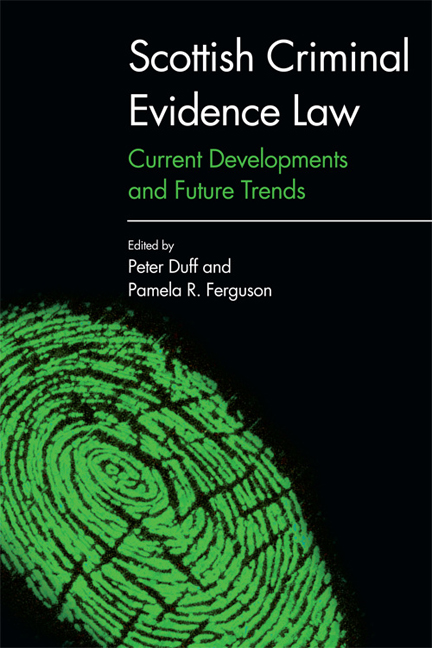Book contents
- Frontmatter
- Contents
- The Contributors
- Acknowledgements
- Table of Cases
- Table of Legislation
- Introduction
- 1 Cadder and Beyond: Suspects’ Rights and the Public Interest
- 2 ‘Access to Justice’ for Complainers? The Pitfalls of the Scottish Government’s Case to Abolish Corroboration
- 3 The Relevance of Sexual History and Vulnerability in the Prosecution of Sexual Offences
- 4 ‘Similar Fact’ Evidence and Moorov: Time For Rationalisation?
- 5 Hearsay in Scots law: Rethinking and Reforming
- 6 Eyewitness Identification Evidence and its Problems: Recommendations for Change
- 7 Assessing Witness Credibility and reliability: Engaging Experts and Disengaging Gage?
- 8 The process of Criminal Evidence Law Reform in Scotland: what Can We Learn?
- 9 Scottish Criminal Evidence Law Adrift?
- Bibliography
- Index
5 - Hearsay in Scots law: Rethinking and Reforming
Published online by Cambridge University Press: 24 April 2021
- Frontmatter
- Contents
- The Contributors
- Acknowledgements
- Table of Cases
- Table of Legislation
- Introduction
- 1 Cadder and Beyond: Suspects’ Rights and the Public Interest
- 2 ‘Access to Justice’ for Complainers? The Pitfalls of the Scottish Government’s Case to Abolish Corroboration
- 3 The Relevance of Sexual History and Vulnerability in the Prosecution of Sexual Offences
- 4 ‘Similar Fact’ Evidence and Moorov: Time For Rationalisation?
- 5 Hearsay in Scots law: Rethinking and Reforming
- 6 Eyewitness Identification Evidence and its Problems: Recommendations for Change
- 7 Assessing Witness Credibility and reliability: Engaging Experts and Disengaging Gage?
- 8 The process of Criminal Evidence Law Reform in Scotland: what Can We Learn?
- 9 Scottish Criminal Evidence Law Adrift?
- Bibliography
- Index
Summary
INTRODUCTION
This chapter considers ways in which the Scots law of hearsay evidence in criminal proceedings can and should be developed. If anything is uncontroversial about the law of hearsay it is that it is complicated, difficult to apply in legal practice and highly challenging to teach. It is clear that there is a ‘rule against hearsay’ but beyond that there is little else that is straightforward or generally accepted.
Hearsay is sometimes divided into primary and secondary but the meanings of these terms are counter-intuitive. Primary hearsay is direct evidence that a statement was made (irrespective of its truth or falsehood) and is admissible for that (or similar) purpose. But for some writers such evidence does not amount to hearsay at all. By contrast secondary hearsay is evidence of the truth of what is contained in a statement made by someone other than a witness. This is often viewed as the only type of hearsay in its proper sense.
There is a second distinction that largely, but not entirely, corresponds to the distinction between the two types of hearsay. This is concerned with the purpose for which hearsay evidence can be used. Here the distinction is between (1) evidence which is used to prove the fact contained within the statement (secondary or ‘proper’ hearsay); and (2) evidence used for some other purpose. This purpose could be to prove the fact that a statement was made, irrespective of its truth (primary hearsay); but it could be some other purpose (for example, relating to the credibility or reliability of a witness). These last uses of evidence involve the seemingly difficult task of accepting hearsay as evidence for such a purpose whilst ignoring the possible truth of the statement it contains. Yet the law is content to leave this task to fact-finders in criminal trials, both judges and juries. This chapter will be concerned with hearsay in its more obvious and direct sense, that is, so-called secondary hearsay. A definition of hearsay in this sense which has been often adopted is one first formulated by Rupert Cross in describing the rule against hearsay: an assertion other than one made by a person while giving oral evidence in the proceedings is inadmissible as evidence of any fact asserted.
- Type
- Chapter
- Information
- Scottish Criminal Evidence LawCurrent Developments and Future Trends, pp. 121 - 138Publisher: Edinburgh University PressPrint publication year: 2017

